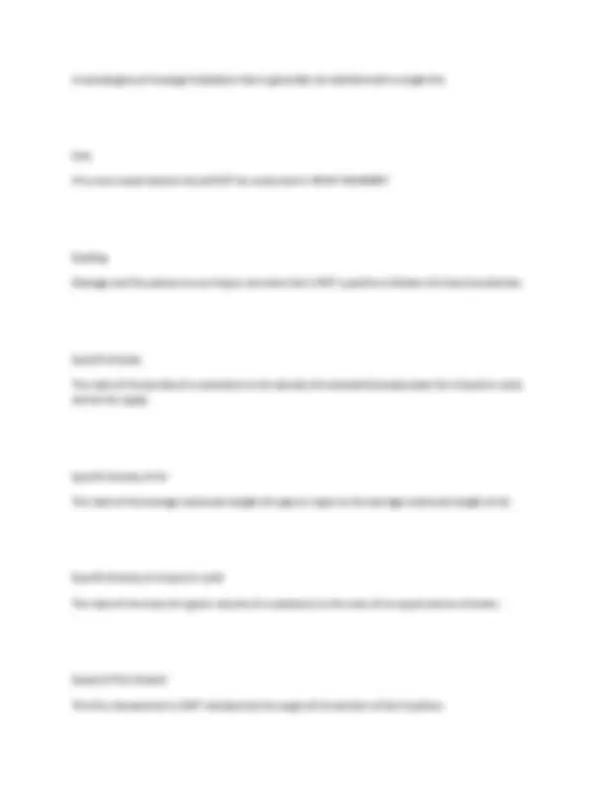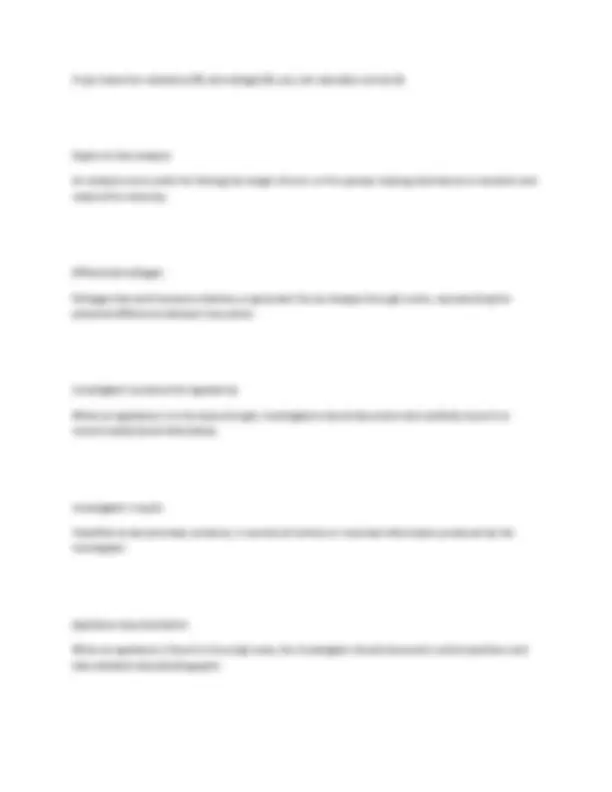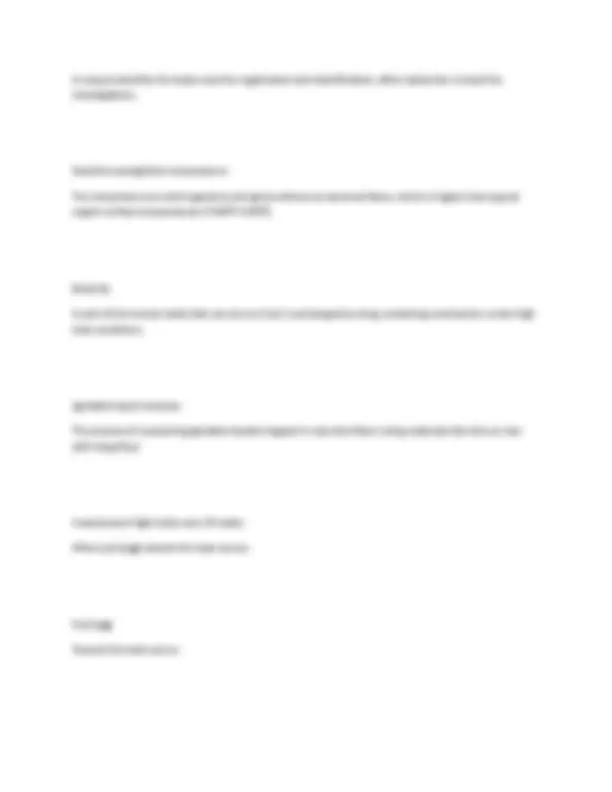




















































Study with the several resources on Docsity

Earn points by helping other students or get them with a premium plan


Prepare for your exams
Study with the several resources on Docsity

Earn points to download
Earn points by helping other students or get them with a premium plan
Community
Ask the community for help and clear up your study doubts
Discover the best universities in your country according to Docsity users
Free resources
Download our free guides on studying techniques, anxiety management strategies, and thesis advice from Docsity tutors
IAAI CFI Exam 2025-2026 WITH COMPLETE QUESTIONS AND CORRECTLY WELL DEFINED ANSWERS WITH 100% GUARANTEED PASS EXAM 2025- 2026/ IAAI CFI Exam
Typology: Exams
1 / 58

This page cannot be seen from the preview
Don't miss anything!



















































Combustible Liquid A liquid with a flash point ABOVE 100F Current Flow If the current flowing out from an electrical panel is 12.5 amps, and it then flows through an electrical load of 1500 watts, what is the amperage of the remaining current flow of the return circuit? Power (P) Power (P) = current (I) x voltage (V) Watts Watts = amps x volts Year of NFPA 1033 First Edition 1987 Recommended Distance for Securing Blast Scene 1.5 times the distance from the furthest debris
Onset of Flashover Temperature 1100°F Copper Melting Temperature 1960°F Radiant Heat Flux Measurement 2 W/cm2 indicates the onset of flashover Voltage at Service Entrance Cables 240 volts between the two hot wires in most single-family residences in the United States NFPA 921 Revision Cycle 3 years Flash Point of Power Steering Fluid 350°F
After-market Equipment A type of device in a vehicle, which can cause an electrical overload to factory installed wiring Alive and Breathing Evidence of smoke or soot in the lungs, bronchi, and trachea is one of the most significant factors in confirming that, at the time of the fire, the victim was alive. All Team Members Those who have the responsibility for monitoring safety conditions at the fire or explosion scene Melting Temperature of Aluminum 1220°F Aluminum-to-pavement sparks Considered a competent ignition source. Heat Release Rate A meaningful analysis of a fire requires an understanding of the fire growth, the total heat released, and WHAT?
Arc-fault circuit interrupter What does the term AFCI stand for? And, the 'A' specifically represents what? ASTM The organization that develops standard methods for testing materials. Auto-ignition Initiation of combustion by heat but without a spark or flame. Backdraft A deflagration resulting from the sudden introduction of air into a confined space containing oxygen- deficient products of incomplete combustion. Backfire Flame Arrestor A boat device that owners fail to keep clean, which is a frequent cause of engine compartment fires on boats. Ballast A device on a fluorescent light fixture that transforms the voltage from normal household voltage to a higher voltage.
Most engine fires typically penetrate the interior compartment at this location of the vehicle. Brass Prongs (male ends) An investigator can closely examine this component of a cord to determine if it was plugged into a receptacle. Calcination The chemical and physical changes that occur in gypsum wallboard surfaces during a fire. Carbon Monoxide A narcotic gas that one might be exposed to in the fire. Carbon Monoxide Poisoning This toxic condition does NOT cause a cherry-pink coloration to the skin of the fire victim and is NOT visible on all skin types. Carburetor Backfire This occurrence is the most common open-flame ignition source in non-fuel injected vehicles. Ceiling jet
When the fire plume reaches the ceiling of a room and moves laterally along the ceiling. Christmas Tree An item in the home that burns at a peak HRR of 3000-5000kW, which is hotter than a pool of gasoline or a polyurethane chair. Clean Burn This occurs when intense radiated heat or direct flame contacts a surface during the fire, burning away deposits. Collapsed Furniture Springs This is a fire effect to furniture that does NOT provide the investigators with clues concerning the type of ignition source, but can show fire spread and intensity. Color A fire characteristic that is NOT necessarily an accurate indicator of the flame temperature. Color Codes This feature distinguishes the heat-sensitive bulbs of sprinkler heads from each other. Combustion
Consensus agreement between interested parties should be developed prior to the commencement of WHAT? Crazing Complicated patterns in glass. Crime Scenes A type of scene or circumstances, in which fires do NOT always destroy all physical evidence. Current (amperage) A factor in OHM's law that can be calculated if you know resistance and voltage. Deductive Reasoning The reasoning in the scientific method used to test a hypothesis. Demonstrative Evidence Type of evidence consisting of tangible items as opposed to Testimonial Evidence or Documentary (written) Evidence. Depth of Char
A burn pattern analysis that is MORE useful for evaluating fire spread, rather than length or intensity of burning. Differential All voltages are ___________________, which means that a battery or DC generator creates a potential difference that can force charge through a wire. Diffusion Flame Burning The ordinary sustained burning mode in most fires. Document and Carefully Move By taking these two steps, an investigator can obtain the manufacturer's name, model & serial numbers, manufacture date, and any warnings on an appliance, determined to be in the area of fire origin. Documentary Evidence What type of evidence is an investigator's report? DOT Standards The standards that gas cylinders must conform to (Dept. of Transportation) Dual Element Fuses
Exigent Circumstances The justification used to enter a property in order to extinguish a fire Final Hypothesis "Conclusions" Fire Death Team A team comprised of a homicide detective, medical examiner, and fire investigator Fire Dynamics Analysis A type of analysis used to predict fire phenomena and characteristics of the environment Fire Effects Observable or measurable changes in or on a material as the result of a fire Fire Growth Rate Once a fuel is ignited in a motor vehicle, any additional fuels contained in the vehicle have significant effect on fire intensity. Fire Intensity
In a wildland fire, this fire characteristic is indicated by the degree of damage to the wildland fuel Fire Origin This investigative determination is based on witness information, fire patterns, arc mapping, and fire dynamics Fire Scene Access The fifth and sixth amendments DO NOT answer questions regarding constitutional protections in relation to fire investigation aspect (4th amendment issue) Fire Scene Reconstruction Recreating pre-fire positions of contents Fire-rated Door This type of door must be used when installed in a fire-rated wall. First or Second Degree Burns This is the typical extent of thermal injuries sustained from an explosion flame front, due to the very short duration. Flame Spread Rating
Flashover In this phenomenon, the radiant ignition of exposed combustible materials is key. Floor Assemblies These construction features are tested for fire spread from below, but NOT from above. Forced and Natural The two mechanisms of convection heat transfer. Freedom of Information Act This law allows fire investigators to gain information, in most states. Fuel load Total quantity of combustible contents of a building, space, or fire area (expressed in heat units or the equivalent weight in wood). Fuel System This system in a vehicle has the following sequence of components: Fuel tank, fuel pump, fuel injector/carburetor, manifold, and cylinders.
Fuel-controlled Burning Type of burning that occurs in the early stages of a compartment fire. Remote Area The location where firefighters should re-fuel all gas-powered equipment (away from the fire scene). Government Institute NFPA is not this type of institute. Guide NFPA 921 is this type of document. Guidelines NFPA 921 establishes WHAT? Hazards Biological, chemical, physical, and radiological are examples of this concept that fire investigators should be aware of when investigating a fire scene.
The type of number an investigator should look for during a boat fire investigation. Hot Surfaces This vehicle component will NOT usually ignite gasoline. Human Body Fat Component of the human body that will act as a fuel and sustain a flame. Hypergolic Material Any substance that will spontaneously ignite or explode upon exposure to an oxidizer. Hypergolic Materials Materials that can react with each other. Ignitable Liquid A type of material that, when trapped in a concrete floor, can be recovered by using lime, diatomaceous earth, or non-self-rising flour.
Ignition by Electrical Energy Ignition that involves transferring sufficient heat to a fuel by passage of electrical current to ignite material that is closeby. Ignition Temperature The minimum temperature needed to heat a fuel so as to ignite and begin self-sustained combustion. Incandescent Light Bulbs An item that tends to 'pull' toward the heat source (*if over 25 watts). Incendiary Fire A category of fire that is strongly indicated by the confirmation of multiple fires. Incident Scene Commander This person can grant permission for a fire investigator to enter a scene before the fire is completely extinguished. Inductive Reasoning The reasoning process of moving from specific observation to broader generalizations.